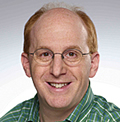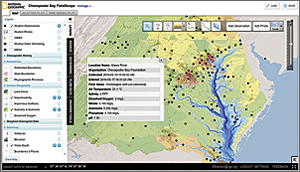Unlocking the Educational Potential of Citizen Science
"Geo Learning"
![]() A column by Daniel C. Edelson,
A column by Daniel C. Edelson,
Vice President for Education, National Geographic Society
 I have been a fan of citizen science for many years, but I do not think the citizen science movement has had the educational impact that it could. Citizen science is the name for scientific research projects that engage members of the public in some aspect of their research. There have been some high-profile citizen science projects recently in which members of the public have conducted image analysis and solved protein-folding problems, but the overwhelming majority of citizen science projects involve crowdsourced data collection.
I have been a fan of citizen science for many years, but I do not think the citizen science movement has had the educational impact that it could. Citizen science is the name for scientific research projects that engage members of the public in some aspect of their research. There have been some high-profile citizen science projects recently in which members of the public have conducted image analysis and solved protein-folding problems, but the overwhelming majority of citizen science projects involve crowdsourced data collection.
For example, some of the largest and longest-running citizen science projects are in ornithology. In projects like the National Audubon Society's Christmas Bird Count and the British Trust for Ornithology's Garden Birdwatch, birders contribute their observations to databases that scientists use to track trends in bird populations and species distributions.
These two projects, like many others, fall into a category of citizen science project that I call community geography. In community geography projects, the data is georeferenced and used for spatial analysis.
Community geography projects can be a boon for researchers. Volunteer data collectors provide investigators with the opportunity to obtain a quantity and geographic range of data that would not be practical through any other mechanism. They are also a boon to participants, who get to join a community; participate in something meaningful; and, in many cases, learn some new science.
For as long as I've known about them, I've been fascinated by the educational possibilities of community geography projects. I'm a big believer in both inquiry-based learning and breaking down the boundaries between school and the real world. Community geography does both—except for one thing. Collecting data is only one part of the scientific process, and most community geography projects only engage participants in data collection.
In the stereotypical community geography project, participants take measurements or record observations and submit them to a central database for scientists to analyze. In some cases, participants are able to see a map of the data that has been submitted or see results of previous analyses that have been conducted by scientists. However, it is very rare that participants have a chance to create and interpret visualizations or analyze data themselves.

A FieldScope map from the Chesapeake Water Quality Project showing a student's water quality measurement.
After talking to organizers of community geography projects, I've learned that most of them would prefer to provide their participants with opportunities to work with the data, but they lack the resources or expertise to create tools that would enable their participants to do their own visualization or analysis.
So, a few years ago, National Geographic—with support from Esri and others—set out to create a web-based platform for community geography that would provide participants with the ability to visualize and analyze their own data using GIS. We call this platform FieldScope. The idea behind FieldScope is that it is designed specifically to support citizen scientists—individuals who are interested and invested in researching a specific scientific question but who lack the training or technical skills of a scientist. This has required that we create easy-to-use interfaces and offer users a set of analytic tools that are either familiar or easy for a novice to grasp.
One of the first FieldScope projects that we deployed is dedicated to studying water quality in the tributaries to the Chesapeake Bay. Working together with environmental educators throughout the Chesapeake Bay watershed, we identified a set of water quality measurements that could be done by students and teachers across a wide range of grades, and we created a FieldScope application that displays not just student-collected water quality data but also a wide variety of data layers describing the land in the watershed, including land use, impermeability, and nitrogen yield.
We also provided users with analysis tools that enable them to create time plots and scatterplots for the data that they have collected, and we implemented a set of hydrologic analysis tools that will help them understand the underlying dynamics of the watershed. For example, we have provided users with a flow path tool that allows them to click anywhere in the watershed and see the path that water will flow from that point to the bay. Users might employ this tool to see the portion of the river system that would be affected by a point source of pollution.
This Chesapeake water quality project has proved very popular in public schools; in the two years that it has been active, more than 600 teachers have received training on the software, and we have recorded more than 40,000 visits to the site. It is also succeeding in engaging users in analysis. In the first three quarters of 2011, we recorded more than 75,000 geoprocessing events and more than 45,000 uses of the query tools.
In the 2011–12 school year, both Fairfax County, Virginia, and Anne Arundel County, Maryland, have incorporated the project into their science curricula for all middle school students.
With support from the National Science Foundation, we are currently in the process of expanding FieldScope's functionality and creating authoring tools that will enable the broadest possible community of citizen science projects to build FieldScope applications for their own users. This spring, we will be launching FieldScope applications for two national community geography projects: Project BudBurst, which is studying plant phenology, and Frogwatch, USA, which is studying the distribution of amphibian species.
FieldScope, with its carefully designed user interface and specially selected GIS tools, is beginning to unlock the potential of citizen science as a learning experience. Teachers and students have responded enthusiastically to the opportunity to participate in geospatial analysis of data. In part, their enthusiasm stems from the fact that it's data about their own community that they helped collect. Administrators, in turn, are seeing that the entire experience of community geography is enabling them to achieve important learning outcomes for both science understanding and science skills.
Our goal over the next few years is to bring this powerful educational experience to as broad an audience as possible, young and old, in school and out.
You can follow Daniel Edelson on Twitter at NatGeoEdelson.
Read other articles in the GeoLearning series.